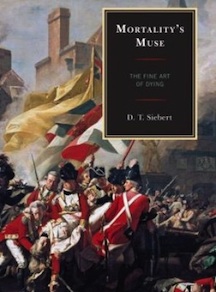By Benjamin Franklin Martin
D. T. Siebert asks what is the ars moriendi (art of dying), what is ataraxia (tranquility of mind while dying) when “human life is enacted within the shadow of death”? His darkly eloquent Mortality’s Muse answers that “art. . . can often create meaning and beauty out of suffering and death.”
The issue mattered more in centuries past, when thanatos (preoccupation with death) held greater sway over Western Civilization. To the subsequent glorification of eros (life force) and the current celebration of hedonism, times past warn, sic transit gloria mundi (thus the glory of the world passes away). The fear and anguish of dying is followed ineluctably by the extinction and putrefaction of death.
Siebert presents tragedy as one means by which “art gives shape and meaning to mortality.” For “The Myth of Sisyphus” (1942), Albert Camus borrowed from Greek mythology a hero accepting without complaint his implacable sentence for daring to affront the Olympian gods. The final lines of William Ernest Henley’s “Invictus” (1875) bravely declared that he alone was responsible for his fate. The Scottish philosopher David Hume portrayed the nobility of English King Charles I facing execution in 1649 and then confronted his own death in 1776 with similar serenity. Friedrich Nietzsche’s The Birth of Tragedy (1872) celebrated this defiance of death for transmuting tribulation into triumph.
Because such courage is always short in supply, Siebert offers as well the “elegiac sense of life,” with its nostalgia and melancholy reminding of the precious to be cherished. He cites above all Thomas Gray, for whose “Elegy Written in a Country Churchyard” (1751) the joys and sorrows of the unknown mattered no less than those of the famous because the same end awaited them all. Mortally wounded in 1759 on the Plains of Abraham in the battle for Quebec, the British General James Wolfe quoted Gray’s line, “The paths of glory lead but to the grave.” Siebert adds A. E. Housman’s collection, A Shropshire Lad (1896), poems mourning, tender, and evocative, especially the wistful “With Rue My Heart Is Laden.” The elegy is both a memento mori (remember that you will die) and an adjuration to carpe diem (seize the day).
Siebert acknowledges, “What art offers us is but a partial consolation, a stay against our despair,” yet he insists that it “gives form, and sometimes even meaning, dignity, and beauty, to the messy, ugly formlessness of death’s work.” As Robinson Jeffers wrote in “To the Stone-Cutters” (1925), a verse Siebert greatly admires, “pained thoughts” have “found the honey of peace in old poems.”
Benjamin Franklin Martin (ΦΒΚ, Davidson College, 1969) is the Price Professor of History at Louisiana State University and a resident member of the Beta of Louisiana Chapter of Phi Beta Kappa.




